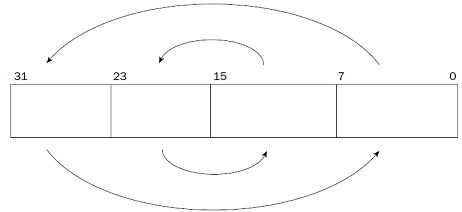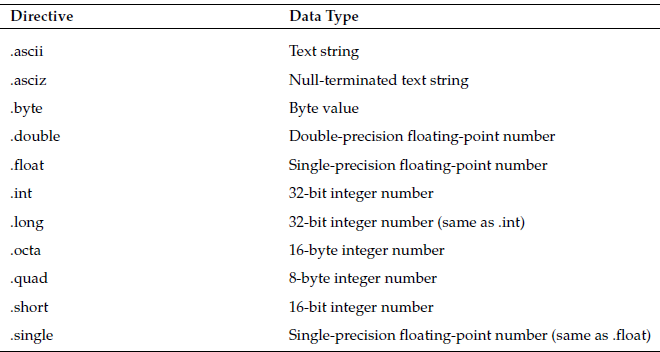(gdb) x/4x &values
0x402000
(gdb) x/4t &values
0x402000
$ ./i.a
$ echo $?
100
CF Carry flag A mathematical expression has created a carry or borrow
OF Overflow flag An integer value is either too large or too small
PF Parity flag The register contains corrupt data from a mathematical operation
SF Sign flag Indicates whether the result is negative or positive
ZF Zero flag The result of the mathematical operation is zero
Instruction Pair .......Description ..............EFLAGS Condition
CMOVA/CMOVNBE ......Above/not below or equal .....(CF or ZF) = 0
CMOVAE/CMOVNB ......Above or equal/not below .....CF=0
CMOVNC .............Not carry ....................CF=0
CMOVB/CMOVNAE ......Below/not above or equal .....CF=1
CMOVC ..............Carry ........................CF=1
CMOVBE/CMOVNA ......Below or equal/not above .....(CF or ZF) = 1
CMOVE/CMOVZ ........Equal/zero ...................ZF=1
CMOVNE/CMOVNZ ......Not equal/not zero ...........ZF=0
CMOVP/CMOVPE .......Parity/parity even ...........PF=1
CMOVNP/CMOVPO ......Not parity/parity odd ........PF=0
CMOVGE/CMOVNL ......Greater or equal/not less ....(SF xor OF)=0
CMOVL/CMOVNGE ......Less/not greater or equal ....(SF xor OF)=1
CMOVLE/CMOVNG ......Less or equal/not greater ....((SF xor OF) or ZF)=1
CMOVO ..............Overflow .....................OF=1
CMOVNO .............Not overflow .................OF=0
CMOVS ..............Sign (negative) ..............SF=1
CMOVNS .............Not sign (non-negative) ......SF=0
# cmv
.section .data
output:
.asciz “The largest value is %d\n”
va:
.int 105, 235, 61, 315, 134, 221, 53, 145, 117, 5
.section .text
.globl _start
_start:
nop
movl va, %ebx
movl $1, %edi
loop:
movl va(, %edi, 4), %eax
cmp %ebx, %eax
cmova %eax, %ebx
inc %edi
cmp $10, %edi
jne loop
pushl %ebx
pushl $output
call printf
addl $8, %esp
pushl $0
call exit
(gdb) s
14 movl va(, %edi, 4), %eax
(gdb) s
15 cmp %ebx, %eax
(gdb) print $eax
$1 = 235
(gdb) print $ebx
$2 = 105
(gdb) s
16 cmova %eax, %ebx
(gdb) s
17 inc %edi
(gdb) print $ebx
$3 = 235
$ ./cmv
The largest value is 315
exchange of values:
MOVW %AX , %CX # TMP , cx spare register
MOVW %BX , %AX
MOVW %CX , %AX
The BSWAP instruction reverses the order of the bytes in a register.

It is important to remember that the bits are not reversed; but rather, the individual bytes contained within the register are reversed. This produces a big-endian value from a little-endian value, and visa versa.
movl $0x12345678, %ebx #######
Current language: auto; currently asm
(gdb) step
_start () at swaptest.s:
bswap %ebx ######## (gdb) print/x $ebx
$1 = 0x12345678
(gdb) step
_start () at swaptest.s:7
7 movl $1, %eax ######## after this instruction the bytes result reversed
(gdb) print/x $ebx
$2 = 0x78563412 ############ 4 bytes reversed

XADD
The XADD instruction is used to exchange the values between two registers, or a memory location and a register, add the values, and then store them in the destination location (either a register or a memory location). The format of the XADD instruction is
xadd source, destination
where source must be a register, and destination can be either a register or a memory location, and contains the results of the addition. The registers can be 8-, 16-, or 32-bit register values.
CMPXCHG
The CMPXCHG instruction compares the destination operand with the value in the EAX, AX, or AL registers. If the values are equal, the value of the source operand value is loaded into the destination operand. If the values are not equal, the destination operand value is loaded into the EAX, AX, or AL registers. The CMPXCHG instruction is not available on processors earlier than the 80486. In the GNU assembler, the format of the CMPXCHG instruction is
cmpxchg source, destination
which is the reverse of the Intel documents. The destination operand can be an 8-, 16-, or 32-bit register, or a memory location. The source operand must be a register whose size matches the destination operand.
# prog
.section .data
data:
.int 10
.section .text
.globl _start
_start:
nop
movl $10, %eax
movl $5, %ebx
cmpxchg %ebx, data
movl $1, %eax
int $0x80
The memory location referenced by the data label is compared with the value in the EAX register using the CMPXCHG instruction. Because they are equal, the value in the source operand (EBX) is loaded in the data memory location, and the value in the EBX register remains the same. You can check this behavior using the debugger:
(gdb) run
9 movl $10, %eax
(gdb) step
10 movl $5, %ebx
(gdb) step
11 cmpxchg %ebx, data
(gdb) x/d &data
0x8049090 : 10
(gdb) s
12 movl $1, %eax
(gdb) print $eax $3 = 10
(gdb) print $ebx
$4 = 5 (gdb) x/d &data
0x8049090 : 5
(gdb)
Before the CMPXCHG instruction, the value of the data memory location is 10, which matches the value set in the EAX register. After the CMPXCHG instruction, the value in EBX (which is 5) is moved to the data memory location.
Because that value does not match the value in EAX, you will notice that the data value is not changed, but the EAX value now contains the value you set in the data label.
//8
.section .data
dat:
.byte 0x88, 0x77 , 0x66, 0x55, 0x44, 0x33, 0x22, 0x11
.section .text
.globl _start
_start:
nop
movl $0x88776655 , %edx #32 bit
movl $0x44332211 , %eax
movl $0x22222222 , %ecx
movl $0x11111111 , %ebx
cmpxchg8b dat
movl $0 , %ebx
movl $1 , %eax
int $0x80
(gdb) x/2x &dat
0x402000
//88 .section .data
dat:
.byte 0x11, 0x22 , 0x33, 0x44, 0x55, 0x66, 0x77, 0x88
.section .text
.globl _start
_start:
nop
movl $0x88776655 , %edx
movl $0x44332211 , %eax
movl $0x22222222 , %ecx
movl $0x11111111 , %ebx
cmpxchg8b dat
movl $0 , %ebx
movl $1 , %eax
int $0x80
(gdb) x/2x &dat
0x402000
movl $va, %edi
This instruction moves the memory address of the label VA to the EDI register.
The dollar sign ($) before the label name instructs the assembler to use the memory address, and not the data value located at the address.
next instruction:
movl %ebx, (%edi)
is the other half of the indirect addressing mode.
Without the parentheses around the EDI register, the instruction would just load the value in the EBX register to the EDI register. With the parentheses around the EDI register, the instruction instead moves the value in the EBX register to the memory location, the label VA, contained in the EDI register.
This is a very powerful tool. Similar to pointers in C and C++, it enables you to control memory address locations with a register. The real power is realized by incrementing the indirect addressing value contained in the register.
movl %edx, 4(%edi)
This instruction places the value contained in the EDX register in the memory location 4 bytes after the location pointed to by the EDI register. You can also go in the opposite direction:
movl %edx, -4(&edi)
This instruction places the value in the memory location 4 bytes before the location pointed to by the EDI register.
